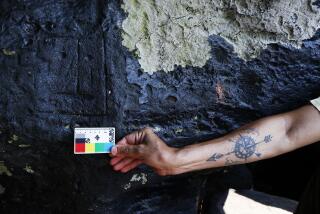Rich Trove of Indian Artifacts Surfaces After Flooding of Potomac River
ROMNEY, W.Va. â John Pancake was searching for bodies along the South Branch of the Potomac River following a 1985 flood when he discovered remains that have changed the way archeologists view a former Indian tribe.
What Pancake found was a long-forgotten Susquehannock village that had been buried beneath his brotherâs once-fertile cornfield before the floodwaters scooped away the rich, thick topsoil.
The Pancakesâ father, meandering along the river decades ago, had uncovered bones, arrowheads and fish hooks. But no one at the time realized the significance.
The village remained concealed until heavy rains pushed into West Virginia in the first week of November, 1985, forcing record flooding along nearly every river in the eastern half of the state. The death toll was 43, with four people still missing.
âWe were out looking for bodies a couple of months after the flood and I saw some bones up along the bank,â Pancake said. âWe never knew the bones were human until we found a skull.â
Permanent Group
Nobody killed in the flood would have been reduced to a skeleton that fast, so John, his brother Joe, and the rest of the family contacted the state Culture and History Department. The department sent them to U.S. Forest Service archeologist Janet Brashler, who excavated part of the site on her own time last year.
The Susquehannocks at Romney âappear to have been a somewhat permanent group,â Brashler said. âTo some extent, itâs surprising to see that.â
The remains of at least 24 Susquehannocks have been identified, including one infant and two adolescents.
âThis showed there were whole families there,â Brashler said. Previously, most Indian settlements in West Virginia were presumed to be just hunting and fishing camps.
The site hugs the South Branch in a mile-wide valley seven miles south of Romney. Each shower uncovers a few more fragments of pottery and bone, and the Pancakes have a 6-foot levee and an electric barbed-wire fence to keep out water and unwelcome visitors.
Why the Susquehannocks settled there will never be known for certain, Brashler said.
âTheir homeland was around the New York-Pennsylvania border on the upper Susquehanna River in the early 1500s and they started moving down the river, possibly encountering other groups along the way,â she said.
Search Ended
Their search for an area where they would encounter little resistance could have ended when they reached the Potomac, Brashler said.
Or, the Susquehannocks may have set up their community near present-day Romney because they were âtrading middlemenâ between tribes further inland and European fishermen along the coast.
âGeographically, itâs strategic, but itâs a little early for them to be setting themselves up in trading. I mean, this is only 60 years after Columbus.
âThe lack of beads, in my mind, fails to support the idea they were trading. Iâm not so sure I like the other theory either, though,â she said.
Twelve bodies, most buried with their legs and arms tucked in in a traditional Susquehannock manner, were recovered intact and parts of 12 to 14 other Indians were identified. There was no pattern to the burials and no mounds to call attention to a lost civilization.
The Indians grew corn and pumpkin, cultivated wild plants and hunted bear, deer and elk, Brashler said. A 15- to 20-foot-tall palisade in an arc around the riverside settlement âprotected them from critters in the night,â she said.
The Susquehannocks decorated themselves with bangles and other ornaments probably of European origin and cooked with ceramics fashioned by their own hand.
âThe style of ceramics and other kinds of artifacts suggests they were there in the mid-1500s,â Brashler said.
The âdebris of the 16th centuryâ is being stored in Brashlerâs basement and bones collected at the site are being analyzed.
After hunting and fishing âuntil they wore out the place,â the Susquehannocks moved back to what is now central Pennsylvania and eventually were killed off by European settlers and their new diseases. Their former home lay dormant, each flood depositing silt on what remained.
The site is outside of U.S. Forest Service jurisdiction, but Brashler plans to reconstruct the settlement on paper, using her own time and money, if necessary.
âWhen we return to the site, we are going to have to return with skilled professionals,â Brashler said.
âThoughtless and unskilled digging damages the record forever. Itâs like tearing pages out of a book. Because this site is important in filling out the history of the Susquehannocks, itâs like burning a chapter off a book.â
More to Read
Sign up for Essential California
The most important California stories and recommendations in your inbox every morning.
You may occasionally receive promotional content from the Los Angeles Times.










